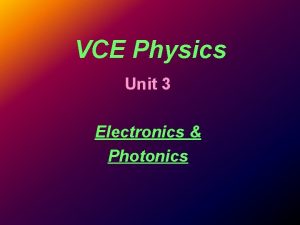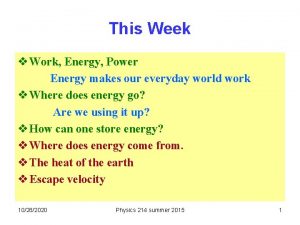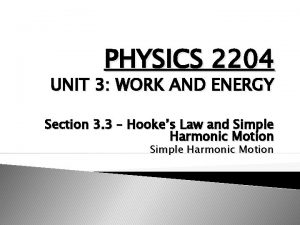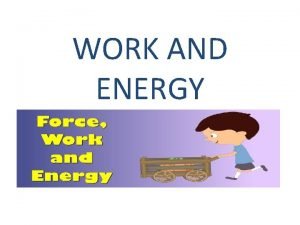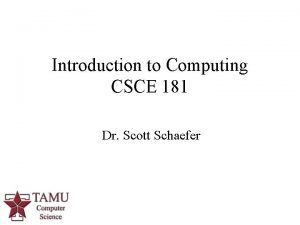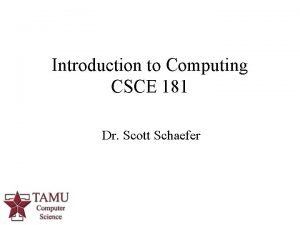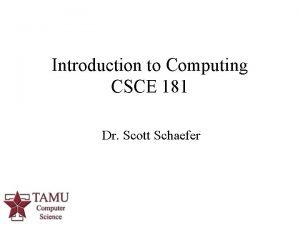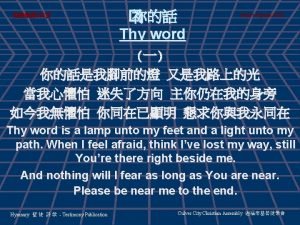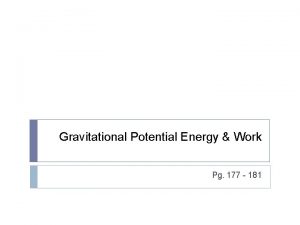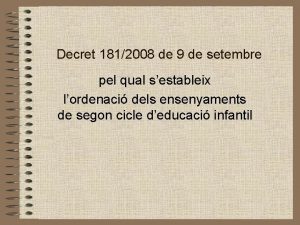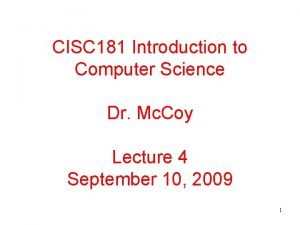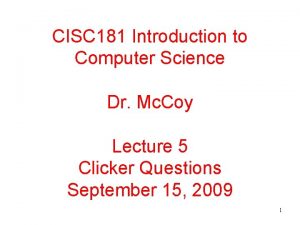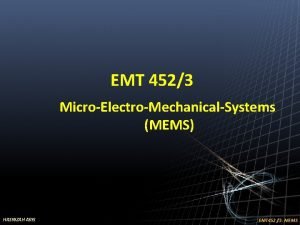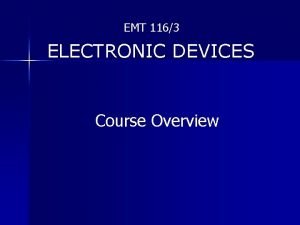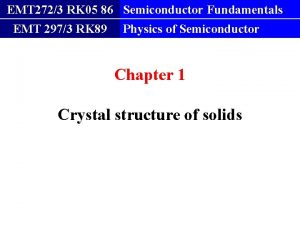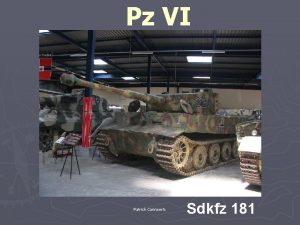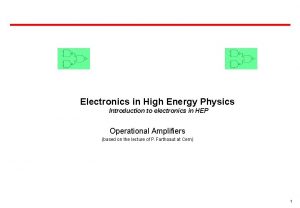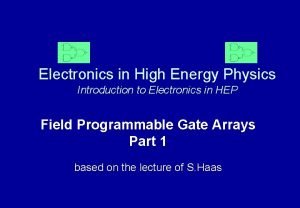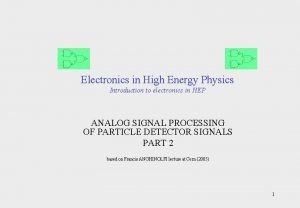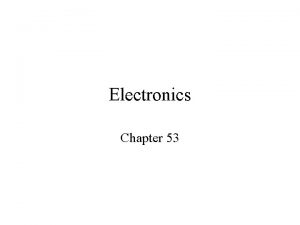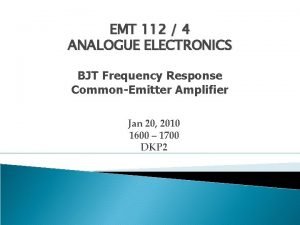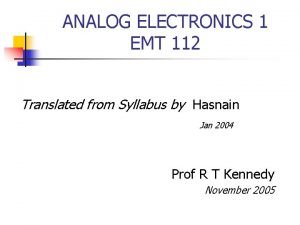WORK ENERGY EMT 181 Physics for Electronics Work




























- Slides: 28

WORK & ENERGY EMT 181 Physics for Electronics

Work & Energy § Definition of quantities such as position, velocity, acceleration and force and associate principle such as Newton’s second law have allowed us to solve variety of problems. § The concept of Energy is one of the most important topic in science and engineering. It also can be applied to mechanical systems without resorting to Newton’s law. Furthermore, the energy approach allows us to understand thermal and electrical phenomena. EMT 181 Physics for Electronics

Work & Energy • System and Environments A valid system: May be a single object or particle. May be a collection of objects or particles. May be a region of space (such as the interior of an automobile engine combustion cylinder) Ø May vary with time in size and shape (such as a rubber ball, which deforms upon striking a wall). § No matter what the particular system is in a given problem, we identify a system boundary, an imaginary surface and the environment surrounding the systems. E. g. a force applied to an object in empty space. § There a number of mechanisms by which a system can be influenced by its environment. But, first, we shall investigate is ‘work’. § Ø Ø Ø EMT 181 Physics for Electronics

Work & Energy • Work Done by a Constant Force § The work W done on a system by an agent exerting a constant force on the system is the product of the magnitude F of the force, the magnitude of r of the displacement of the point of application of the force, and cos , where is the angle between the force and displacement vectors: Is the SCALAR quantity, even though it is defined in terms of two vectors: a force F and displacement r. We will explore how to combine two vectors to generate a scalar quantity. The displacement in above eq. is that of the point of application of the force. A force does no work on the object if the force does not move through a displacement, if r = 0 gives W = 0.

Work & Energy § Also notice from work equation, the work done by a force on a moving object is zero when the force applied is perpendicular to the displacement of its point of application. That is, if = 90, then W = 0 because cos 90 = 0. E. g. work done by the normal force (n) on the object and the work done by the gravitational force (mg) on the object are both zero because both forces are perpendicular to the displacement, and have zero components along an axis in the direction of r. § The sign of the work also depends on the direction of F relative to r. § The work done is +ve (W=+ve) when the projection of F onto r in the same direction as the displacement. E. g. when object is lifted, the W is +ve because the direction of F is upward, in the same direction as the displacement of its point of application. § W=-ve, when the projection of F onto r is in the opposite direction with displacement. E. g. object is falling, the W done by gravitational force is –ve. § The factor cos in the definition of W automatically takes care of the sign. If F is in the same direction as r, then = 0 and cos 0 = 1, thus, W = F r.

Work & Energy § § § The SI unit of work is N. m = kg. m 2 /s 2. Or usually/frequently used as Joule (J). Work is an energy transfer. If W is +ve : energy is transferred to the system. If W is –ve: energy is transferred from the system. If a system interacts with its environment, this interaction can be described as a transfer of energy across the system boundary.

Work & Energy Math Review The scalar product or dot product of two vectors gives a scalar result: vector • vector = scalar

Sca. Iar product and cartesian components: (note the right-hand-side is a single scalar) To prove this, expand using the laws of arithmetic (distributive, commutative), and notice that since, i, j, k are mutually perpendicular and since they are unit vectors

Work & Energy • EXAMPLE: A particle moving in the xy plane undergoes a displacement given by m as a constant force N acts on the particle. Calculate the work done by force F on the particle.

Work & Energy Work Done by a Varying Force § Consider a particle being displaced along the x axis under the action of a force that varies with position. § The particle is displaced in the direction of increasing x from x = xi to x = xf. § In such a situation, we cannot used W = F r cos because this relationship applies only for constant F. § If particle undergoes a very small displacement x, the component of Fx is approximately constant over the small interval, thus Or approximately equal to the sum of a large number of such term:

Forces which are not constant: Example: How much work is done to stretch a spring scale from zero to the 20 -N mark (a distance of 10 cm)? We can’t just multiply “force times distance” because the force changes during the motion. Our definition of “work” is not complete. Varying force: split displacement into short segments over which F is nearly constant. F(x) x For each small displacement Dx, the work done is approximately F(x) Dx, which is the area of the rectangle. F Dx

We get the total work by adding up the work done in all the small steps. As we let Dx become small, this becomes the area under the curve, and the sum becomes an integral. F(x) A x Split displacement into short steps Dx over which F is nearly constant. . . Work is the area x Take the limit as Dx 0 and the number of steps (A) under a graph of force vs. distance

In 1 D (motion along the x-axis): Another way to look at it: Suppose W(x) is the total work done in moving a particle to position x. The extra work to move it an additional small distance Dx is, approximately, DW F(x) Dx. Rearrange to get In the limit as Dx goes to zero,

Work & Energy Example: An Ideal Spring (Work Done by a Spring). Hooke’s Law: The tension in a spring is proportional to the distance stretched. or, |F| = k|s| - dimensional analysis The spring constant k has units of N/m Directions: The force exerted by the spring when it is stretched in the +x direction is opposite the direction of the stretch (it is a restoring force): F = -kx Vector form:

Work & Energy Example: Work by a Spring Fs Spring force: Fs= - kx Find a function W(x) so that If xi = xf , then W = 0

Work & Energy Kinetic Energy & the Work-Kinetic Energy Theorem § The work-kinetic energy theorem: “When work is done on a system and the only change in the system is in its speed, the net work done on the system equals the change in the kinetic energy of the system”. § One possible of doing work on a system is that the system changes its speed – called ‘kinetic energy’.

Work & Energy Potential Energy of a System § The work done by the external agent on the system (object and the Earth) as the object undergoes the upward force (Fapp) and the upward displacement is given by: § Thus, we identify the quantity mgy as the gravitational potential energy: For both vertical and horizontal components:

Work & Energy Elastic Potential Energy § The work done by an external applied force on a system consisting of a block connected to the spring is given by § Thus, the elastic potential energy function associated with the block-spring is defined by § The elastic potential energy of the system can be thought of as the energy stored in the deformed spring (either compressed or stretched from it equilibrium).

Work & Energy Conservative and Non-conservative Forces v Conservative Force § Have two equivalent properties: (1) The work done on a particle moving between any two points is independent of the path taken by the particle. (2) The work done on a particle moving through any closed path is zero. A close path is one for which the beginning point and the endpoint are identical. v Non-conservative Force A force is non-conservative if it does not satisfy properties 1 and 2 for conservative force. We define the sum of kinetic energy (K) and potential energy (U) of a system as the mechanical energy:

Work & Energy Relationship Between Conservative Forces & Potential Energy § The work done by a conservative force acting between members of a system equals the negative of the change in the potential energy of the system associated with that force when the system’s configuration changes. § The conservative force is related to the potential energy function through the relationship: § In the case of deformed spring Us = ½ kx 2 ; therefore:

Work & Energy Diagrams & Equilibrium of a System U x=0 position for block-spring system. Net force on a member of the system is zero. Stable equilibrium x 0 Unstable equilibrium Particle accelerates away from x = 0 Correspond to U(x) is a maximum Energy diagram A ball lying on a flat, Neutral equilibrium horizontal surface, where U is constant.

Work & Energy Conservation of Energy v Analysis Model: Non-isolated System (Energy) § Mechanism to transfer energy: Ø Work By applying a force to the system – the point of application of the force undergoes a displacement. Ø Mechanical Waves (MW) Transferring energy by allowing a disturbance to propagate through air or another medium. Ø Matter transfer (MT) Matter physically crosses the boundary of a system, carrying energy on it. Ø Electrical transmission (ET) Involves energy transfer into or out of system by means of electrical currents. Ø Electromagnetic radiation (ER) Refers to EM waves such as light, microwaves and radio waves crossing the boundary of a system.

Work & Energy Analysis Model: Non-isolated System (Energy) § Therefore, if the total amount of energy in a system changes, it can only be because energy has crossed the boundary of the system by a transfer mechanism such as one of the method listed previously. § The is no equivalent in the concept of energy to dying or giving birth. § The general statement of the principle of conservation of energy can be describe mathematically with the conservation of energy equation: where Esystem is the total energy of the system (K, U, and internal energies), and T (for transfer) is the amount of energy transferred across the system boundary by some mechanism. The full expression of above eq. is

Work & Energy Analysis Model: Isolated System (Energy) § Previously, we define mechanical energy as the sum of K and U, where But for isolated system, Thus, the mechanical energy of the system is conserved (conservation of mechanical energy) with no non-conservative force acting, where § If non-conservative forces act in an isolated system, the total energy is conserved although the mechanical energy is not. Mathematically express as where Esystem includes all K, U and internal energies. If the energy is change, thus

Work & Energy Power § The time rate of energy transfer is called the instantaneous power P, and it is defined as § If an external force is applied to an object (particle) and if the work done by this force on the object in the time interval t is W, then the average power during this interval is § The SI unit of power is J/s, also called watt (W).

Work & Energy EXERCISE V: 1) A trophy being shown off by a careless athlete slips from the athlete’s hands and drops on his toe. Choosing floor level as they y = 0 point of your coordinate system, estimate the change in gravitational potential energy of the trophy-Earth system as the trophy falls. Repeat the calculation, using the top of the athlete’s head as the origin of coordinates. 2) A common technique used to measure the force constant of a spring is demonstrated. The spring is hung vertically and an object of mass m is attached to its lower end. Under the action of the ‘load’ mg, the spring stretches a distance d from its equilibrium position. (a) If a spring is stretched 2. 0 cm by a suspended object having a mass of 0. 55 kg, what is the force constant of the spring? (b) How much work is done by the spring on the object as it stretches through this distance?

Work & Energy 3) A 6. 0 kg block initially at rest is pulled to the right along the horizontal surface by a constant horizontal for of 12 N. (a) Determine the speed of the block after it has moved 3. 0 m if the surfaces is contact have a coefficient of kinetic friction of 0. 15. (b) Suppose the force F is applied at an angle . At what angle should the force be applied to achieve the largest possible speed after the block has moved 3. 0 m to the right? 4) A block of mass 1. 6 kg is attached to a horizontal spring that has a force constant of 103 N/m. The spring is compressed 2. 0 cm and is then released from rest. (a) Calculate the speed of the block as it passes through the equilibrium position x = 0 if the surface is frictionless. (b) Determine the speed of the block as it passes through the equilibrium position if a constant friction force of 4. 0 N retards its motion from the moment it is released.

Work & Energy 5) Two blocks are connected by a light string that passes over a frictionless pulley. The block of mass m 1 lies on a horizontal surface and is connected to a spring of force constant k. The system is released from rest when the spring is unstretched. If the hanging block of mass m 2 falls a distance h before coming to rest, determine the coefficient of kinetic friction between the block of mass m 1 and the surface. 6) An elevator car has a mass of 1600 kg and is carrying passengers having a combined mass of 200 kg. A constant friction force of 4000 N retards its motion. (a) How much power must a motor deliver to lift the elevator car and its passengers at a constant speed of 3 m/s? (b) What power must the motor deliver at the instant the speed of the elevator is v if the motor is designed to provide the elevator car with an upward acceleration of 1 m/s 2 ?
 Physics 03-06 impulse and momentum answer key
Physics 03-06 impulse and momentum answer key Electronics, photonics and device physics
Electronics, photonics and device physics Regents physics work power energy
Regents physics work power energy Kinetic energy formula
Kinetic energy formula Joule units
Joule units Physics 2204 unit 3: work, power, energy
Physics 2204 unit 3: work, power, energy Define work energy theorem
Define work energy theorem Sources of chemical energy
Sources of chemical energy Opwekking 181
Opwekking 181 Ms 181 weebly
Ms 181 weebly Csce 181
Csce 181 Csce 181
Csce 181 Csce 181 tamu
Csce 181 tamu Sda hymn 100
Sda hymn 100 Thy 181
Thy 181 Wac 181-87-060
Wac 181-87-060 181
181 181
181 Decret 181/2008, de 9 de setembre
Decret 181/2008, de 9 de setembre Cisc 181
Cisc 181 Dönem ayırıcı hesaplar nedir
Dönem ayırıcı hesaplar nedir Dönem ayirici hesaplar 180 181 280 281 380 381
Dönem ayirici hesaplar 180 181 280 281 380 381 Cisc 181
Cisc 181 Energy energy transfer and general energy analysis
Energy energy transfer and general energy analysis Energy energy transfer and general energy analysis
Energy energy transfer and general energy analysis Emt competence framework
Emt competence framework Emt setup
Emt setup Direct ground lift emt
Direct ground lift emt Chapter 24 trauma overview
Chapter 24 trauma overview

